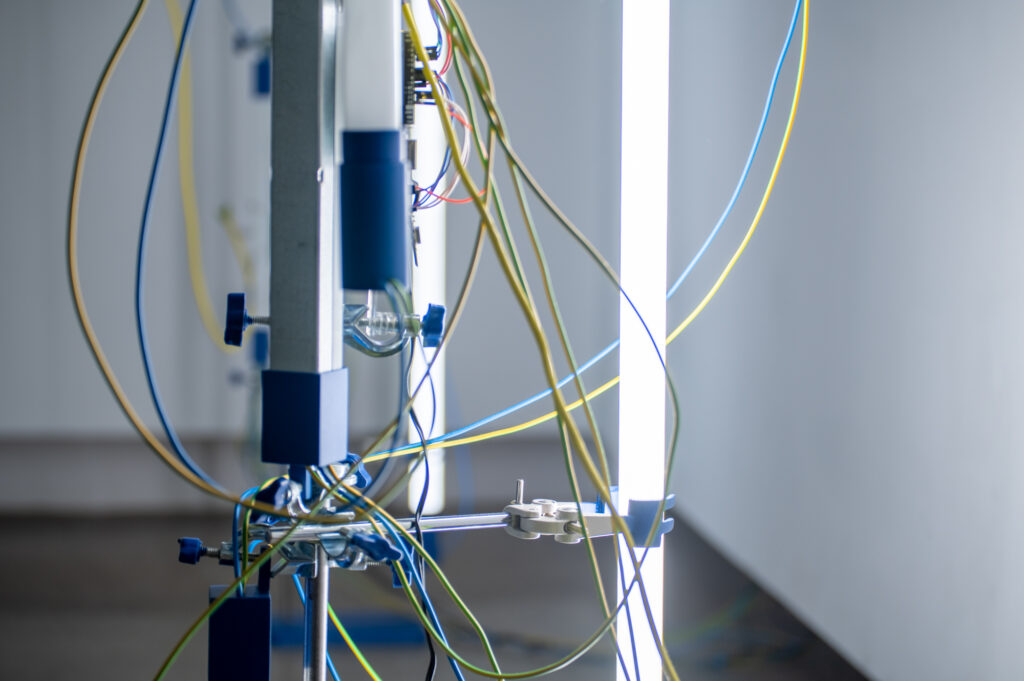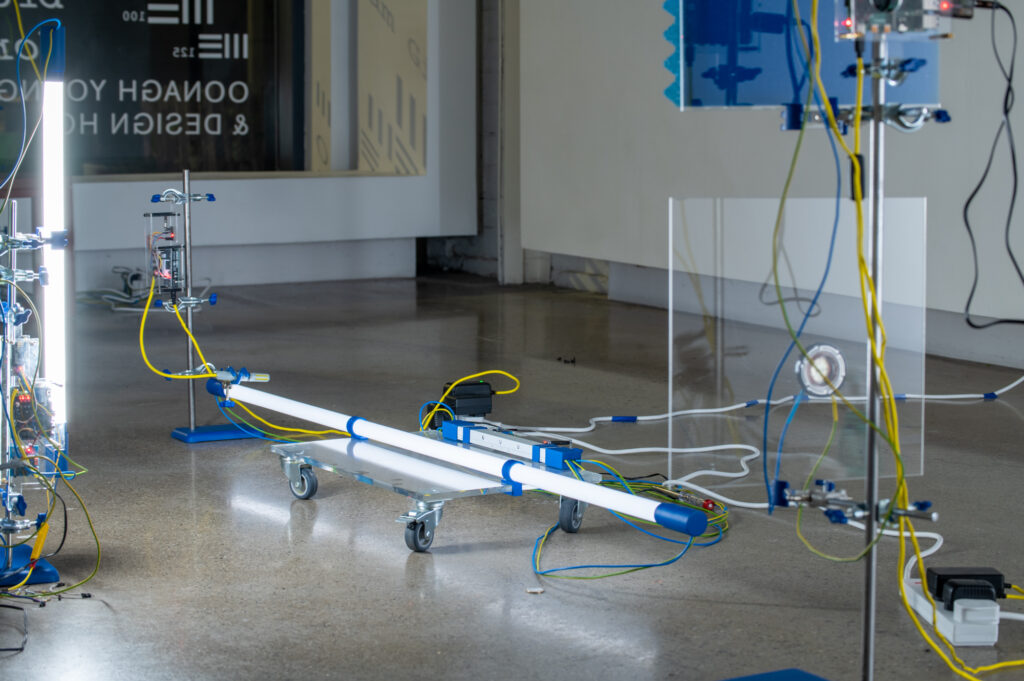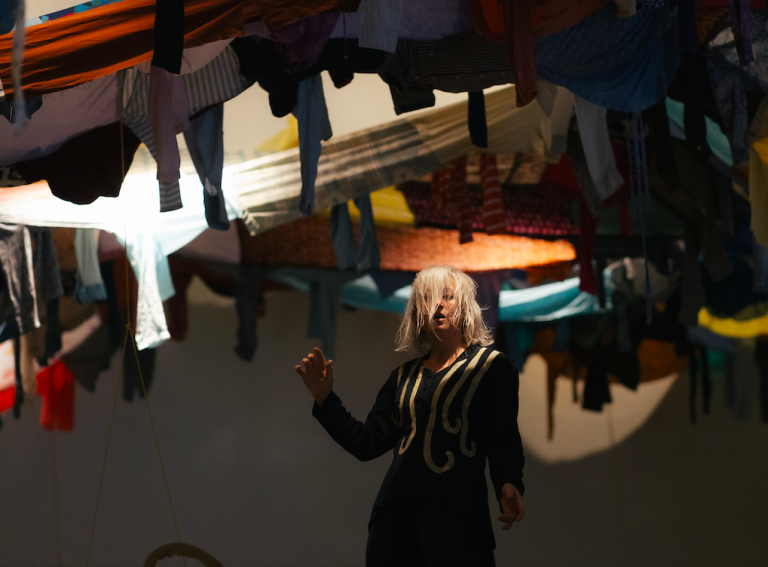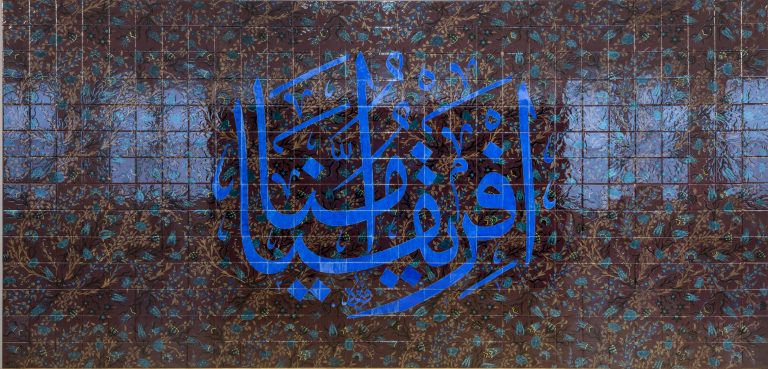In psychology textbooks, the human mind is often equated to something like a computer. The eyes and ears feed data to a calculating brain to produce some kind of outcome; a sequential flowchart from input, to computation, to output. This computer metaphor – which underlies so much modern cognitive science – is, in essence, a repetition of a century-old dualism, a distinction between mind and matter, between the conscious and unconscious. It’s an analogism that not only allows us to think of the mind as a product of this machine-like brain, but also to imagine an actual machine as a brain that could produce a mind.
In Can_you_breathe_for_me? at Oonagh Young Gallery, Adam Gibney presents a series of artworks that attempts to interrogate these notions. The space feels like a portable laboratory, composed of a series of provisional assemblages. These sculptures, oriented and clamped in place by retort stands, present the viewer with a maker’s playground: breadboards and microcomputers, cut Plexiglas on castor wheels, acoustic foam, and microphones, all connected by cabling. Their tentative arrangement – the fact they could be so easily taken apart and reconfigured – suggests they are still being worked on, that the experiment is still taking place. In fact, I have the odd feeling that I’ve stumbled into this particular lab after hours. The gallery lights are turned off, and besides the ambient light from the window, the only other illumination in the room comes from the arrhythmic glow of the artworks’ fluorescent tubing.
Adam Gibney
Can_you_breathe_for_me?, 2021
Installation view, Oonagh Young Gallery
Photo: Claire Nash
Courtesy of the artist
Inkjet prints are hung on two of the gallery’s walls. They show digitally mangled landscapes, glitching plumes of smoke, reminiscent of Takeshi Murata’s early experiments with data moshing. There’s the suggestion of a human form in both prints: in one, a pair of legs maybe; in the other, a silhouette in side profile. The titles of both prints begin with the phrase ‘Guru says’. As I dig further into the information in the press release, I realise that all the artwork titles have been computer-generated, composed by an AI text generator, trained on transcripts of guided mediation videos. This is the Guru. And these prints I’m looking at on the walls are generated based on what the Guru says. The figure I see isn’t anything at all really. It’s the equivalent of an algorithmic Rorschach test.

Adam Gibney
Guru says (53): and those good feelings will hold you into this beautiful energy that you are part of the earth on you, 2021
Inkjet print on archival paper
Photo: Claire Nash
Courtesy of the artist
Some fragments of the Guru’s psyche are further revealed in the first of the sculptural assemblages encountered in the space, Instruction 07: Now, exhale … A microphone points towards me. As the gallery door closes, it creates a sound loud enough to trigger a programmatic routine. An algorithm hunts through YouTube for guided mediation videos. It searches specifically for videos that contain the word ‘exhale’. As this is happening, an LCD screen shows the black background and white text of a Terminal window, scrolling through a series of operations. The short pulse of a sine tone rings out to announce the playback of a video. From the video’s audio, the voice of a meditation facilitator can be heard, kindly asking us to breath in and then slowly exhale. (At other times – and depending on what video the algorithm selects – New Age music might play out into the space, along with the facilitator’s voice or an image of a glassy-calm lake might glow from the assemblage’s screen.) At the back of the gallery space, an artwork titled Exercise 29: Exhaling comes to life, fulfilling the facilitator’s instructions. A fan begins to spin, pushing air towards an anemometer, which starts cycling; a florescent tube flickers in synergy with its rotations.

Adam Gibney
Exercise 29: Exhaling, 2021
Courtesy of the artist
For Instruction 05: Nirvana Focus Test, a camera points towards a focusing chart affixed to the window. On the side of the artwork’s assemblage of stands and circuitry, a small LCD screen shows the live feed of the camera’s point of view: a greyscale image of the gallery window and James Joyce Street beyond it. The camera’s lens pushes in and out, as if breathing. The view from the screen mirrors this, veering in and out of focus. When the camera focuses just enough to recognise the chart on the window, a servo motor whirrs into life briefly, swivelling a metal rod from which a small bell rings.
When the bell first rings, I am in another part of the gallery space, and quickly return to inspect the apparatus. I look at the bell, then the screen, and start to think about the Guru. The bell might be a reference to the kind of bell used in mindfulness-based meditation. A way of focusing attention. But as I look at the LCD screen – its dimensions somewhere between that of a mobile phone and a tablet – I also start to think about distraction, and how – like Pavlov and his famous dogs – I’ve been conditioned to immediately reach for my phone when I hear its notification sound.
I place my hand in front of the camera and it focuses for long enough to pass the truth condition in Gibney’s computer code. The bell rings. I try the same thing again, flashing my hand in front of the camera. Nothing. And then again. Nothing. Having been drawn to this contraption by the sound of its bell, I wonder am I being conditioned by this machine too?

Adam Gibney
Instruction 05: Nirvana Focus Test (detail), 2021
Courtesy of the artist
In some sense, the assemblages in Gibney’s exhibition can be described as models of mindfulness; an expression of a monistic, Eastern philosophy, rather than a Western dualistic one. They function by being ‘present’ in the world, in a way that is synergised by their ability to sense and change in direct relation to their environment. They unify the physical and non-physical, rather than separating them.
At the same time, these artworks might also be described as models of perceiving and acting. And in this way, they belong to a lineage of philosophical ideas that includes William James’s doctrine of radical empiricism and the phenomenology of Maurice Merleau-Ponty. Both of these theories are notable attempts to understand the perceptual processes that allow us to make sense of the endless information around us – the world of ‘pure experience’ or ‘flux’, as James referred to it. Gibney’s interest in such ideas extends to the present day through the more recent developments of extended cognition and enactivism. As a counterargument to cognitive psychology’s detached model of the mind-as-a-computer, enactivism (and its related varieties) proposes that the human mind is a product of focused, embodied activity. The less-than-intuitive implication of this is notion is that the mind ought to be sought in the environment, rather than in the brain. Consciousness is created via the codependant actions of perceiving and moving. These capacities are in essence mutually generating, much like the actions of the camera Nirvana Focus Test as it constantly changes its focus to see more clearly.

Adam Gibney
Instruction 01: Breathe for me (detail), 2021
Courtesy of the artist
It may also seem less-than-intuitive to draw such comparisons between enactivism and the artworks exhibited in Can_you_breathe_for_me?, given that these assemblages operate via microcomputers and machine-based components. But Gibney’s artworks are not a mere replication of the computer metaphor. The non-dualistic ideal exemplified in Gibney’s work can be understood in parallel to various emergent-based systems, ranging from machine learning and artificial intelligence to the uncanny four-legged robots made by Boston Dynamics.
This delicate, ever-evolving circularity between sensing and acting is most eloquently realised by Gibney in Instruction 01: Breathe for me. Here, three assemblages of apparatus sit together in the middle of the gallery space, each working in correspondence with the rest to create variations in light, sound, and humidity, allowing the overall ‘system’ of the artwork to operate in perpetuity.

Adam Gibney
Instruction 01: Breathe for me (detail), 2021
Courtesy of the artist
The humidity reading from one assemblage creates flares of ‘breathing’ light to radiate from the florescent tube of another. A third assemblage takes measurement from the tubing to give voice to the system’s panting, which emerges as a modulating electronic drone from square cuttings of transparent Plexiglas, being excited by a set of transducers. The solid form of this plastic material becomes fluid as it vibrates, as if becoming part of the air around it. A conical flask sits alongside, releasing water vapour into the room when the humidity drops below the equilibrating limit of the system. And so the cycle continues.
Beyond the technical proficiency of the work, what makes artworks like Instruction 01: Breathe for me so compelling is their ability to feed from their surroundings to operate autonomously of human intervention. They possess some kind of living, conscious quality. This is something that’s further reinforced by the visual language of the laboratory. There’s a protean or developing feeling, a sense that these objects are always on the cusp of becoming … Or maybe they’re in the process of transcending, to think of the Guru again. The absorption of the outside to the inside, and out again. A circularity. Like breathing.
Christopher Steenson is an artist from Northern Ireland, whose practice encompasses sound, writing, and photography. He has recently been selected to participate in the PS2 Freelands Artist Programme for 2022–23. His upcoming exhibition Soft Rains Will Come will be presented at VISUAL Centre for Contemporary Art, Carlow, in February 2022.





